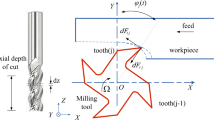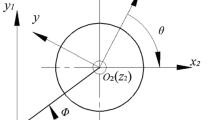Abstract
Helical milling is a high efficiency, high quality hole-making technology, which enjoys very good usage prospects for the aeronautical and aerospace industry. In the helical milling process, the chip thickness is highly variable along the cutting edges and during the tool revolution due to the special cutting trajectory. The aim of this study is to develop a cutting force model and build a new calibration method of cutting force coefficients for helical milling. First, the tool motion of helical milling and the geometry of the chip are analyzed, and then the cutting force model is established. After that the calibration method of cutting force coefficients is built. In the end, a series of cutting experiments were conducted to validate the cutting force model and the calibration method. With this model, it is possible to analyze cutting forces and optimize the cutting parameters, and then get a better quality of hole-making.
Similar content being viewed by others

References
Kim D (2016) Usage of PCD tool in drilling of titanium/graphite hybrid composite laminate. Int J Mach Mach Mater 13(2/3):276–288
Xu J, Mkaddem A, Mansori ME (2016) Recent advances in drilling hybrid FRP/Ti composite: a state-of-the-art review. Compos Struct 135(1):316–338
Zitoune R, Krishnaraj V, Collombet F, Roux SL (2016) Experimental and numerical analysis on drilling of carbon fibre reinforced plastic and aluminium stacks. Compos Struct 146:148–158
Zhao Q, Qin X, Ji C, Li Y, Sun D, Jin Y (2015) Tool life and hole surface integrity studies for hole-making of Ti6Al4V alloy. Int J Adv Manuf Technol 79(5–8):1017–1026
Pereira RBD, Brandao LC, Paiva APD, Ferreira JR, Davim JP (2017) A review of helical milling process. Int J Mach Tools Manuf 120:27–48
Denkena B, Boehnke D, Dege JH (2008) Helical milling of CFRP-titanium layer compounds. CIRP J Manuf Sci Technol 1(2):64–69
Iyer R, Koshy P, Ng E (2007) Helical milling: an enabling technology for hard machining precision holes in AISI D2 tool steel. Int J Mach Tools Manuf 47(2):205–210
Brinksmeier E, Fangmann S, Rentsch R (2011) Drilling of composites and resulting surface integrity. CIRP Ann Manuf Technol 60(1):57–60
Zhou L, Ke Y, Dong H, Chen Z, Gao K (2016) Hole diameter variation and roundness in dry helical milling of CFRP/Ti stacks. Int J Adv Manuf Technol 87(1–4):811–824
Sadek A,MeshrekiM, AttiaMH(2012) Characterization and optimization of helical milling of woven carbon fiber reinforced epoxy laminates. CIRP Ann Manuf Technol 61(1):123–126
Wang M, Liu N, Yingxiang XU, Liu D, Jiang Q (2015) Experimental study on milling force and hole milling quality of helical hole milling for carbon fiber reinforced plastics. Machine Tool & Hydraulics 43(19):40–45
Li Z, Liu Q (2013) Surface topography and roughness in hole-making by helical milling. Int J Adv Manuf Technol 66(9-12):1415–1425
Wang H, Qin X, Ren C et al (2012) Prediction of cutting forces in helical milling process. Int J Adv Manuf Technol 58(9–12):849–859
Altintas Y, Spence A, Tlusty J (1991) End milling force algorithms for CAD systems. CIRP Ann Manuf Technol 40(1):31–34
Li Z, Liu Q, Ming X, Wang X, Dong Y (2014) Cutting force prediction and analytical solution of regenerative chatter stability for helical milling operation. Int J Adv Manuf Technol 73(1):433– 442
Rey PA, LeDref J, Senatore J, Landon Y (2016) Modelling of cutting forces in orbital drilling of titanium alloy Ti-6Al-4V. Int J Mach Tools Manuf 106:75–88
Altintas Y (2012) Manufacturing automation: metal cutting mechanics machine tool vibrations and CNC design, pp 35–47. Cambridge University Press, UK
Segonds S, Landon Y, Monies F, Pierre L (2006) Method for rapid characterisation of cutting forces in end milling considering runout. Int J Mach Mach Mater 1(1):45–61
Tian Y, Liu Y, Wang F, Jing XB, Zhang DW, Liu XP (2017) Modeling and analyses of helical milling process. Int J Adv Manuf Technol 90(1–4):1003–1022
Acknowledgements
The authors are grateful for funding supports by National Natural Science Foundation of China (Nos 51605326 and 51420105007), Science and the Natural Science Foundation of Tianjin (Nos 16JCZDJC38300 and 16PTSYJC00150).
Author information
Authors and Affiliations
Corresponding author
Rights and permissions
About this article
Cite this article
Shang, S., Qin, X.D., Li, J.H. et al. Modelling of cutting forces and researching calibration method in helical milling. Int J Adv Manuf Technol 94, 2949–2960 (2018). https://doi.org/10.1007/s00170-017-1117-0
Received:
Accepted:
Published:
Issue Date:
DOI: https://doi.org/10.1007/s00170-017-1117-0



